
Herman Melville was an American novelist, short story writer, and poet of the American Renaissance period. Among his best-known works are Moby-Dick (1851); Typee (1846), a romanticized account of his experiences in Polynesia; and Billy Budd, Sailor, a posthumously published novella. At the time of his death, Melville was no longer well known to the public, but the 1919 centennial of his birth was the starting point of a Melville revival. Moby-Dick eventually would be considered one of the great American novels.
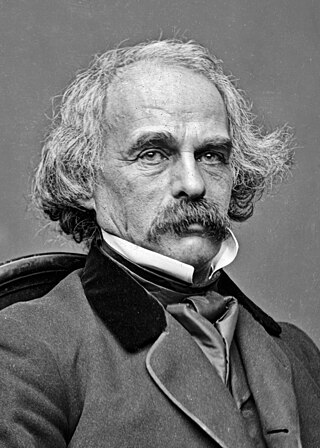
Nathaniel Hawthorne was an American novelist and short story writer. His works often focus on history, morality, and religion.

The Scarlet Letter: A Romance is a work of historical fiction by American author Nathaniel Hawthorne, published in 1850. Set in the Puritan Massachusetts Bay Colony during the years 1642 to 1649, the novel tells the story of Hester Prynne, who conceives a daughter with a man to whom she is not married and then struggles to create a new life of repentance and dignity. As punishment, she must wear a scarlet letter 'A'. Containing a number of religious and historic allusions, the book explores themes of legalism, sin and guilt.
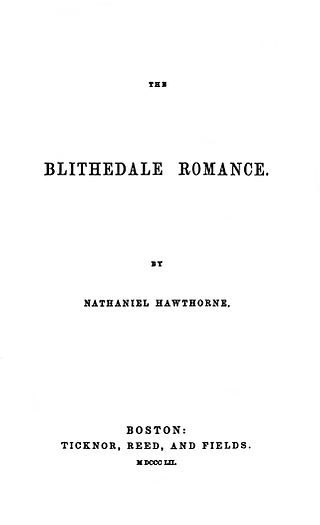
The Blithedale Romance is a novel by American author Nathaniel Hawthorne published in 1852. It is the third major "romance", as he called the form. Its setting is a utopian farming commune based on Brook Farm, of which Hawthorne was a founding member and where he lived in 1841. The novel dramatizes the conflict between the commune's ideals and the members' private desires and romantic rivalries.
Hypnagogia is the transitional state from wakefulness to sleep, also defined as the waning state of consciousness during the onset of sleep. Its opposite state is described as hypnopompia – the transitional state from sleep into wakefulness. Mental phenomena that may occur during this "threshold consciousness" phase include hypnagogic hallucinations, lucid dreaming, and sleep paralysis.

"Young Goodman Brown" is a short story published in 1835 by American writer Nathaniel Hawthorne. The story takes place in 17th-century Puritan New England, a common setting for Hawthorne's works, and addresses the Calvinist/Puritan belief that all of humanity exists in a state of depravity, but that God has destined some to unconditional election through unmerited grace. Hawthorne frequently focuses on the tensions within Puritan culture, yet steeps his stories in the Puritan sense of sin. In a symbolic fashion, the story follows Young Goodman Brown's journey into self-scrutiny, which results in his loss of virtue and belief.

"The Minister's Black Veil" is a short story written by Nathaniel Hawthorne. It was first published in the 1836 edition of The Token and Atlantic Souvenir, edited by Samuel Goodrich. It later appeared in Twice-Told Tales, a collection of short stories by Hawthorne published in 1837.
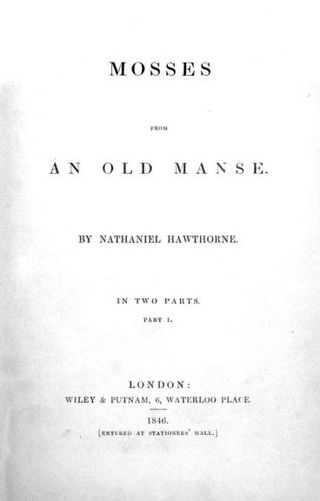
Mosses from an Old Manse is a short story collection by Nathaniel Hawthorne, first published in 1846.
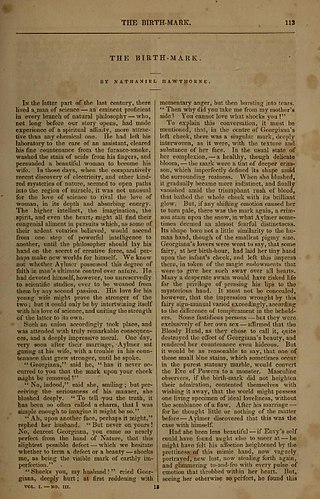
"The Birth-Mark" is a short story by American author Nathaniel Hawthorne. The tale examines obsession with human perfection. It was first published in the March 1843 edition of The Pioneer and later appeared in Mosses from an Old Manse, a collection of Hawthorne's short stories published in 1846.

Twice-Told Tales is a short story collection in two volumes by Nathaniel Hawthorne. The first volume was published in the spring of 1837 and the second in 1842. The stories had all been previously published in magazines and annuals, hence the name.
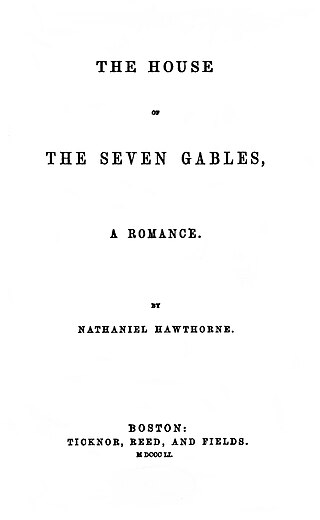
The House of the Seven Gables: A Romance is a Gothic novel written beginning in mid-1850 by American author Nathaniel Hawthorne and published in April 1851 by Ticknor and Fields of Boston. The novel follows a New England family and their ancestral home. In the book, Hawthorne explores themes of guilt, retribution, and atonement, and colors the tale with suggestions of the supernatural and witchcraft. The setting for the book was inspired by the Turner-Ingersoll Mansion, a gabled house in Salem, Massachusetts, belonging to Hawthorne's cousin Susanna Ingersoll, as well as ancestors of Hawthorne who had played a part in the Salem Witch Trials of 1692. The book was well received upon publication and later had a strong influence on the work of H. P. Lovecraft. The House of the Seven Gables has been adapted several times to film and television.
Ego death is a "complete loss of subjective self-identity". The term is used in various intertwined contexts, with related meanings. Jungian psychology uses the synonymous term psychic death, referring to a fundamental transformation of the psyche. In death and rebirth mythology, ego death is a phase of self-surrender and transition, as described by Joseph Campbell in his research on the mythology of the Hero's Journey. It is a recurrent theme in world mythology and is also used as a metaphor in some strands of contemporary western thinking.

"Ethan Brand—A Chapter from an Abortive Romance" is a short story written by Nathaniel Hawthorne in 1850 and first published by Ticknor, Reed, and Fields in 1852 in The Snow-Image, and Other Twice-Told Tales, the author's final collection of short stories. Hawthorne originally planned a lengthy work about Brand, but completed only this piece. Hawthorne's inspiration was a lime kiln he saw burning while climbing Mount Greylock.
Anomalous experiences, such as so-called benign hallucinations, may occur in a person in a state of good mental and physical health, even in the apparent absence of a transient trigger factor such as fatigue, intoxication or sensory deprivation.

"Egotism; or, The Bosom-Serpent" is a short story by Nathaniel Hawthorne published in 1843 in The United States Magazine and Democratic Review in New York.
American gothic fiction is a subgenre of gothic fiction. Elements specific to American Gothic include: rationality versus the irrational, puritanism, guilt, the uncanny, ab-humans, ghosts, and monsters.
"The Celestial Railroad" is short story by American author Nathaniel Hawthorne. In the allegorical tale, Hawthorne adopts the style and content of the seventeenth-century allegory The Pilgrim's Progress by John Bunyan. Where Bunyan's tale portrays a Christian's spiritual "journey" through life, Hawthorne's satirizes many contemporary religious practices and philosophies, including transcendentalism.

"The Great Stone Face" is a short story published by Nathaniel Hawthorne in 1850. The story reappeared in a full-length book, The Snow-Image, and Other Twice-Told Tales, published by Ticknor, Reed & Fields in 1852. It has since been republished and anthologized many times.
Night-Side: Eighteen Tales is a collection of 18 works of short fiction by Joyce Carol Oates published by Vanguard Press in 1977.

In Internet aesthetics, liminal spaces are empty or abandoned places that appear eerie, forlorn, and often surreal. Liminal spaces are commonly places of transition, pertaining to the concept of liminality.












